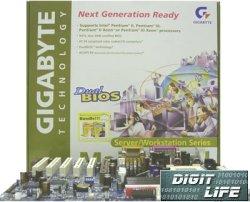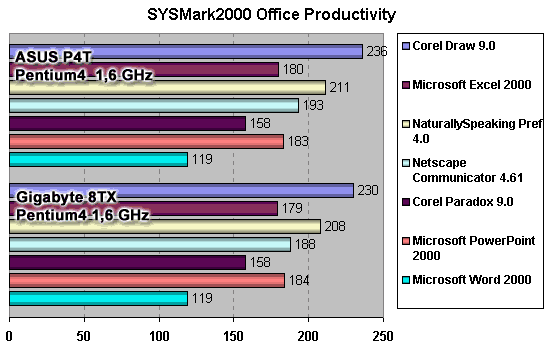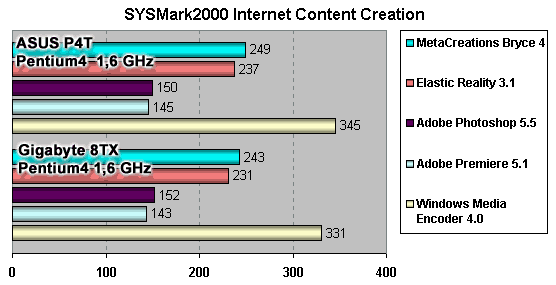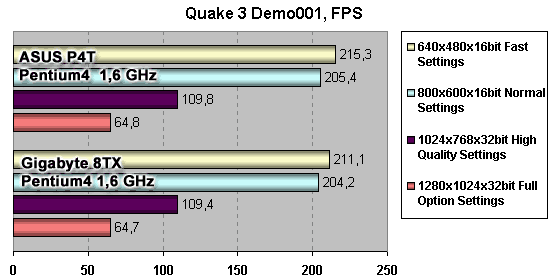 |
||
|
||
| ||
IntroductionNo secret that for vast majority of users the systems based on the Pentium 4 are no more than just a toy for the rich, useless expense etc. Nevertheless, in a definite circle of problems the processor is beyond any competition. And it has already gripped hearts of many fans. Nevertheless, due to the high price of the processor, and mainly of the Rambus memory which is inseparatable part today, the number of selling samples is still not very high, and as a result the production and sale of boards for the Pentium 4 is mainly a matter of prestige than acquisition of income. That's why not every company would manage to invest in such projects; only giants can undertake it, for example ASUS and Gigabyte. But some factors changed the situation dramatically. Delay with the DDR release, unjustified high price of the DDR-memory that exceeds even that of the Rambus and still low performance gain with the usage of DDR system because of raw drivers and BIOS led to the fact that a High-End system on the Pentium 4 in most cases appears more preferable alternative than the DDR system on the Athlon old models, and its price looks not terrible, as it was before, but just stresses that the processor is intended for the high level systems. As a result, the i850 boards transfer from a class of very expensive and unnecessary toys into a class of claimed for and well selling products. The ASUS P4T board considered not so long ago in one of our review proved to be excellent. And today it's turn of the second giant - the Gigabyte company that has launched the Gigabyte 8TX motherboard. It's quite interesting to compare these two contestants. An additional intrigue in such opposition was brought in by the completely different approach of two companies to their High-End mainboards. ASUS doesn't squander their gifts on trifles - e.g. the P4T board doesn't contain the AC'97 sound, but it's equipped with a proprietary chassis which is intended for popularization of the product in the light of absence of the corresponding ATX 2.03 cases and provides reliable support for hypertrophied CPU heatsink. Gigabyte stresses on respectability of their products with proprietary blue textolite and different pleasant stuff such as DualBIOS and sound from Creative, though… But a bit later on it. Even superficial acquaintance proves that the boards differ very much, but it only rouses interest to the Gigabyte 8TX. Specification
 The box size for the Gigabyte 8TX is comparable with boxes for ATX cases. It easily can accommodate a heatsink for the Pentium 4, power supply unit for the ATX 2.03, and chassis etc. But in fact the box does not contain anything striking. The Gigabyte engineers decided that the 8TX board, like the P4T, must be installed into usual ATX cases, but unlike the ASUS, it is enough strong to hold the heatsink on the processor. That's why there are no any additional metallic chassis, and guides for the heatsink are set in the mounting holes next to the socket and fixed with 4 plastic thrusts. Such solution is cheap enough, provides compatibility with old cases, but is it reliable enough? I think that such mounting ensures adjacency strength between the heatsink and the CPU which is comparable with metallic chassis, and as to the board loading, there are two ways. In case your 8TX based system will be stationary installed, it shouldn't cause problems - even considering vertical position of the board 300-500 g of aluminum or copper mustn't damage the bracing badly. But nevertheless, be careful while transporting the board since the risk of damaging is rather high. Heatsink guides have already mounted on the board, clamps are supplied separately, they are quite primitive when comparing to that of the ASUS. Effective cooling requires exactly your skills when working with the mechanical part. In mechanical part, Gigabyte offers much cheaper solution than ASUS. With the full value ATX 2.03 cases with heatsink mounting on the chassis, problems of the 8TX will disappear. The huge box contains the board, two brackets for the RIMM slots, FDD and 80-thread IDE cables, CD with drivers, Acrobat Reader, DX 7A, utilities from Gigabyte, Norton AntiVirus 2000, and user's manual. BoardThe Gigabyte 8TX board follows the reference design of the boards for the Pentium 4, suggested by Intel, so the board loses that exceptionality which is typical for the ASUS P4T - the RIMM slots are located athwart to the expendable slots. On the other hand, serious change in the board layout involves considerable investment, on the other hand, a turn of the board section (including socket, north bridge, RIMM slots and voltage pulse converter) will be appreciated by few. This solution is used for more effective cooling of the hot P4, but according to the monitoring of the 8TX the temp of the CPU has never exceeded 45 C. The board size 24.3 x 30.4 cm allows installing it in practically any ATX case. Traditionally for Gigabyte products, the stability of the board is super. The board was tested with the usage of additional 4-pin power connector, and without it. It allows claiming that with the qualitative and powerful power supply unit the presence of the 4-pin connector, included into the ATX 2.03 specification, is unnecessary. But 235W "noname" power units yields nothing good - the system just don't work due to the power shortage. We detected failures when the motherboard ran with netcards on the Realtek chips - 8029 and 8139 with the BIOS version f2, supplied with the board. A new version of the BIOS f3 of December 15 has solved the problem. The Socket-423 installed parallel to expendable slots has heatsink guides on the right and on the left that's why the north bridge is moved to the left, to the expendable slots. Since the chipset has a record number of pins, the layout requires 6-layer design of the mainboards and quite large area of the textolite around the chipset. As a result, the section with the socket, north bridge and RIMM slots didn't let us locate 6 PCI slots. The board is equipped with AGP Pro slot intended for professional video adapters, 5 PCI slots and a CNR slot shared with the last PCI. The general design of the board has nothing serious to complain about - you can only inform against a connector for the additional feeding between the ports and the socket (the cable touches the fan). Besides, FDD and IDE connectors are located too close to each other, so the mounting of cables gets sometimes difficult. But you can tie together all three cables and therefore ensure better air circulation in the case. The board is equipped with 4 connectors for RDRAM modules, and unlike the ASUS where RIMM modules take turns with brackets, on the 8TX when using two modules they are installed in the first two slots and the brackets - in the third and in the fourth. With 4 512 MBytes RIMM modules the memory size can reach 2 GBytes. The proprietary technology of Gigabyte - Dual BIOS - is still developing. It is based on two BIOS chips located on the mainboard. In case of damage of the first BIOS it can be restored with the second one. The company developed DualBIOS Utility which is located in the BIOS, the access to it is implemented with the F1 key. This utility contains the following changeable settings:
With such options for manipulation with the BIOS's the company Gigabyte remains a trendsetter, despite the fact that there are a lot of board manufacturers that use two BIOS chips on their products, e.g. Chaintech, AOpen etc. The board includes AMI BIOS 1.24. Note that it's poor in settings (the solution from AWARD looks preferable). The RDRAM specification, though, comes with the both - the memory frequency changes - 300 or 400 MHz. And the last pleasant utility is the @BIOS. It is a program working in the Windows. It automatically defines the model of motherboard, connects the Gigabyte's site and downloads the latest BIOS version. At last, we should note that the board is equipped with a full value sound controller Creative CT5880, much more preferable than usual AC'97. OverclockingThe company Gigabyte started paying attention to overclocking possibilities of their board not so long ago, but the new tendency didn't touch the 8TX, that's why we are tightly limited in overclocking. Still, let's see what we can do. The serial Pentium 4 has a locked multiplier and overclocking is possible only with lifting FSB frequency. But the Quad-Pumped Bus can't be compared even with the Pentium III mainboard which had 50 and more percent reserve in frequency. The clock speed is chosen with DIP-switches. There are 4 FSB frequencies: 100, 105, 110 and 133 MHz. The CPU worked only at regular frequency, when at the other - it refused operating. So, the result is poor - overclocking of the Gigabyte 8TX failed. But our processor has unlocked multiplier. The BIOS boards allow setting the multiplier from 8 to 23. Up to 16 everything worked perfect, from 17 to 23 - nothing changed - the processor was frozen at 16 and at 1600 MHz. It's strange… Unclear what was to blame - the CPU, the mainboard or the chipset? PerformanceNow we will choose the best for the struggle against the system based on the Athlon 1.2 GHz + DDR. The following test system aided in performance assessment:
Software:
   The performance of the board is mainly defined by the memory subsystem. No secret that the Rambus memory heats considerably and all chips are covered with the heat-eliminating aluminum finless heatsink. Besides, there is a mode of reduced power consumption for better cooling of memory, switching of which off requires a lot of time. The ASUS P4T prevents it artificially, and as a result the delays become minimum. It seems like exactly this factor defines the less performance shown by the Gigabyte 8TX. It's worth noting that RIMM modules heats with the 8TX considerably less than with the P4T. ConclusionThe board is a perfect product. And considering that the price will get much less than that of the ASUS, we do not know what the Pentium 4 fans will prefer. But the main thing is that the Pentium 4, the future of which was unclear yet not so long ago, acquires good mainboards. The article is not a review on unreachable equipment, but on a quite accessible product… Highs:
Lows:
Write a comment below. No registration needed!
|
Platform · Video · Multimedia · Mobile · Other || About us & Privacy policy · Twitter · Facebook Copyright © Byrds Research & Publishing, Ltd., 1997–2011. All rights reserved. |